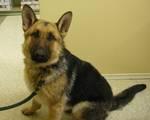
It’s summer! You may be thinking that a hot spot is a sunny locale or a place with a strong wireless signal for your cell phone, but did you know that it is also a sore spot on your dog’s skin? These can be a common problem in the hot, humid weather, so Coventry Animal Hospital wants to make sure you know what to do if your dog has a hot spot!
What is a hot spot?
Canine hot spots are red, inflamed skin lesions also known as pyotraumatic dermatitis or acute moist dermatitis. These inflammatory skin lesions are exacerbated by scratching, can appear quickly and may contain pus. Hot spots can be found anywhere on a dog’s body, but the most common sites are head, legs, and hips. These painful, smelly sores may be very obvious or may be hidden beneath matted fur.
What causes a hot spot?
Hot spots are usually caused by self-trauma when a dog scratches an itchy spot so vigorously that he creates an open wound. Dogs scratch for many reasons, but here are some of the more common underlying causes of hot spots:
- Allergies, including food allergies or inhalant allergies that cause itching.
- Reactions to insect bites from fleas, mites or other small insects (bees, wasps, lice, gnats, etc)
- Ear infections. Bacteria or yeast in the ear canal can be so irritating that the dog scratches at his ear creating hot spots on the ear flap, behind the ear, or on the neck.
- Pyoderma. Primary skin infections also caused by bacteria or yeast may incite the dog to scratch an area so much that a secondary hot spot forms.
- Poor grooming. Dogs with unkempt hair coats bite at tangles, creating open wounds. Matted fur prevents air from reaching the skin and retains water after a dog swims or gets caught in the rain so the skin stays wet. This sets up a perfect environment for a hot spot.
- Orthopedic problems. Dogs with arthritis or back problems tend to lie down much of the time. Lying on one side creates abrasions over pressure points, like hips or hocks, where bony protrusions have little muscular padding, especially in elderly dogs with diminishing muscle mass. When the dog licks the abrasion, a hot spot erupts. Dogs also lick or chew at degenerating joints much like people rub a sore knee to relieve the pain, creating hot spots in the process.
- Anal gland inflammation. Infected or impacted anal glands are painful and annoying. Dogs lick the area around the rectum and can cause hot spots under or on top of the tail.
How are hot spots treated?
The goal in treating a hot spot is to stop the trauma and prevent the development of a deep skin infection, so the first step in treating hot spots is to stop the self mutilation. Some options include:
- An Elizabethan collar (also known as a “cone”) that stops the dog from chewing at the hot spot.
- Medication to reduce the itching which may or may not include steroids, antihistamines, and/or antibiotics.
Often, it takes a combination of all options to stop the trauma.
The underlying cause of the hot spot must also be addressed:
- If the hot spot formed as a result of impacted anal glands, they will need to be expressed.
- If the cause is flea allergy, a flea control protocol must begin and the flea problem in the household must be addressed also. The veterinarians at Coventry Animal Hospital have multiple parasite prevention options and can discuss the best one for your individual situation.
- If arthritis is the culprit, our veterinarian may prescribe pain medications.
- For inhalant or food allergies, we can help you to begin avoidance or de-sensitization therapy and recommend a hypoallergenic food.
- For ear infections, the underlying yeast or bacteria will be treated.
- If poor grooming is the cause, Coventry Animal Hospital has a groomer on staff that can help.
- Clipping the hair away from the hot spot and the surrounding area is crucial to a successful treatment plan. The hot spot will heal much quicker if the hair is removed so that the lesion can dry properly. Grooming may be painful so the dog may need to be sedated.
How can hot spots be prevented?
Coventry Animal Hospital recommends continued monitoring and treatment of the underlying cause to prevent future hot spots. Call us if you think your dog may have a hot spot. We’re here to help you and your dog make the most of this summer!
